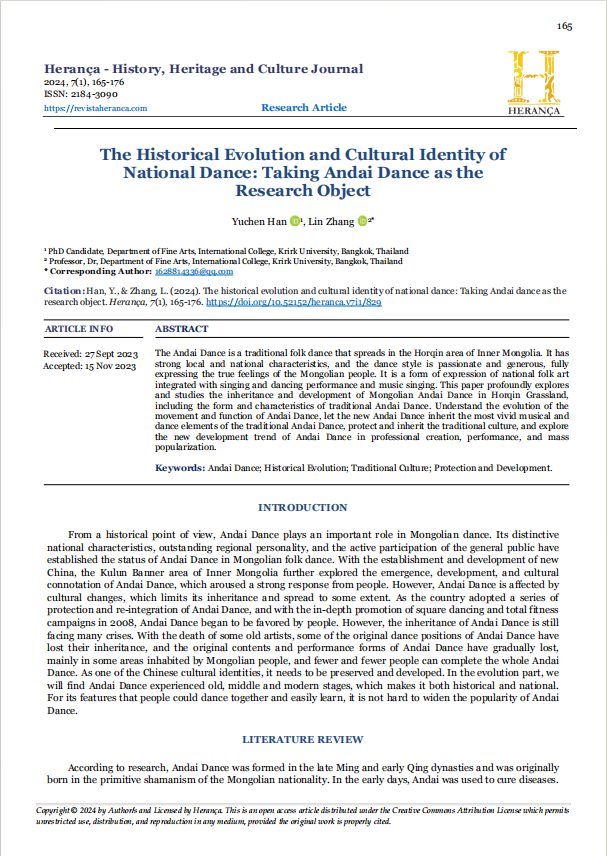The Historical Evolution and Cultural Identity of National Dance: Taking Andai Dance as the Research Object
DOI:
https://doi.org/10.52152/heranca.v7i1.829Palavras-chave:
Andai Dance, Historical Evolution, Traditional Culture, Protection and DevelopmentResumo
The Andai Dance is a traditional folk dance that spreads in the Horqin area of Inner Mongolia. It has strong local and national characteristics, and the dance style is passionate and generous, fully expressing the true feelings of the Mongolian people. It is a form of expression of national folk art integrated with singing and dancing performance and music singing. This paper profoundly explores and studies the inheritance and development of Mongolian Andai Dance in Horqin Grassland, including the form and characteristics of traditional Andai Dance. Understand the evolution of the movement and function of Andai Dance, let the new Andai Dance inherit the most vivid musical and dance elements of the traditional Andai Dance, protect and inherit the traditional culture, and explore the new development trend of Andai Dance in professional creation, performance, and mass popularization.
Downloads
Referências
Aristidou, A., Stavrakis, E., Charalambous, P., Chrysanthou, Y., & Himona, S. L. (2015). Folk dance evaluation using laban movement analysis. Journal on Computing and Cultural Heritage (JOCCH), 8(4), 1-19.
Bayar. (1988). Menggu Mi Shi (Shang) [The secret history of Mongolia (Part 1)]. Hohhot, China: Inner Mongolia People's Publishing House.
Blake, J. (2000). On defining the cultural heritage. International & Comparative Law Quarterly, 49(1), 61-85.
Bowitz, E., & Ibenholt, K. (2009). Economic impacts of cultural heritage—Research and perspectives. Journal of Cultural Heritage, 10(1), 1-8.
Butler, B. (2009). 'Othering' the archive—from exile to inclusion and heritage dignity: The case of Palestinian archival memory. Archival Science, 9, 57-69.
Carter, W. (2016). Criminalizing the destruction of intangible cultural heritage. Anthropology News, 57(12), e62-e65
Chen, Y. H., Wei, Q, M., Yuan, Y. N., & Meng, F. Y. (2012). Cong minjian yishu dao wenhua chanye—"Andai wu" chanyehua guo cheng yanjiu [From folk art to cultural industry—A study on the industrialization process of "Andai Dance"]. Journal of Dalian Institute for Nationalities,14(06), 540-542.
Costa Goes, D. J. (2023). Cultural rights and free access to culture in the pandemic context in mainland Portugal and the autonomous region of Madeira. Herança, 6(2).
Gillman, D. (2010). The idea of cultural heritage. Cambridge, MA: Cambridge University Press
Gilbert, A. G. (2005). Dance education in the 21st century: A global perspective. Journal of Physical Education, Recreation & Dance, 76(5), 26-35.
Hafstein, V. T. (2012). Cultural heritage. A Companion to Folklore, 500-519.
Janke, T., & Iacovino, L. (2012). Keeping cultures alive: Archives and indigenous cultural and intellectual property rights. Archival Science, 12, 151-171.
Li, S. F. & Zhao, Z. W. (2019). Qianxi Menggu zu wudao zhong Andai wu de jianshen jiazhi [Analysis of the fitness value of Andai Dance in Mongolian dance]. Contemporary Sports Science and Technology,9(04), 181-183.
Liu, D. M. (2010). Menggu zu Andai wu fazhan zhihou yuanyin zhi tanjiu [Research on the reasons for the lagging development of the Mongolian Andai Dance]. Journal of Chifeng University (Chinese Philosophy and Social Sciences Edition), 31(02), 166-167.
Liu, M. G. (2012). Lun minsu lei fei wuzhi wenhua yichan de chuancheng, baohu he liyong [On the inheritance, protection and utilization of intangible cultural heritage of folk customs]. Jianghan Forum, (10), 119.
Petronela, T. (2016). The importance of the intangible cultural heritage in the economy. Procedia Economics and Finance, 39, 731-736.
Pimenta, S., Ribeiro, O., & Moreira, F. (2023). Cultural representations of Angola and Mozambique in colonial narratives. Herança, 6(2).
Pujol, L., & Champion, E. (2012). Evaluating presence in cultural heritage projects. International Journal of Heritage Studies, 18(1), 83-102.
Risner, D. (2010). Dance education matters: Rebuilding postsecondary dance education for twenty-first-century relevance and resonance. Journal of Dance Education, 10(4), 95-110.
Rylance, K. (2006). Archives and the Intangible. Archivaria, 62(1), 103-120.
Shay, A. (2014). Choreographing identities: Folk dance, ethnicity and festival in the United States and Canada. Jefferson, NC: McFarland.
Snodgrass, M. E. (2016). The encyclopedia of world folk dance. Lanham, MD: Rowman & Littlefield.
Sun, J. (2018). Qianxi Menggu zu wudao zhong Andai wu de chuancheng yu chuangxin nandian [Analysis of the inheritance and innovation difficulties of Andai Dance in Mongolian dance]. Voice of the Yellow River, (01), 106-107.
Wang, J. & Haas. (2018). Cong Andai zhong tuoyin erchu de Andai wu [Andai Dance stands out from Andai]. Popular Literature and Art, (17), 133-134
Wijesundara, C., & Sugimoto, S. (2018). Metadata model for organizing digital archives of tangible and intangible cultural heritage and linking cultural heritage information in digital space. LIBRES: Library and Information Science Research Electronic Journal, 28(2), 58-80.
Zou, J. Y. (2013). Andai Wu ji qi bianqian de wenhua yanjiu ci—yi Tongliao shi Kulun qi wei ge’an [A cultural study on Andai Dance and its changes—A case study of Kulun Banner in Tongliao City]. Journal of Inner Mongolia University for Nationalities, 39(03), 27-30.
Zhang, L. W. (2007). Lun Andai wu de tezheng ji shehui gongneng [On the characteristics and social functions of Andai Dance]. Journal of Inner Mongolia University for Nationalities: Social Sciences Edition, 33(5), 22-24.
Zhi, X. Y. (2019). Menggu zu Andai Wu de wehua neihan yu chuancheng fangshi [The cultural connotation and inheritance mode of Mongolian Andai Dance]. Voice of the Yellow River, (12), 20.
Zhuang, K. S. (2004). General Theory of Anthropology. Taiyuan, China: Shanxi Education Press.

Downloads
Publicado
Como Citar
Edição
Secção
Licença
Direitos de Autor (c) 2023 Herança - Revista de História, Património e Cultura

Este trabalho encontra-se publicado com a Licença Internacional Creative Commons Atribuição 4.0.






8.png)





